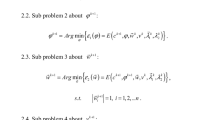Abstract
The Chan-Vese model using variational level set method (VSLM) has been widely used in image segmentation, but its efficiency is a challenge problem due to high computation costs of curvature as well as the Eiknal equation constraint. In this paper, we propose a continuous Max-Flow (CMF) method based on discrete graph cut approach to solve the VSLM for image segmentation. Firstly, we recast the original Chan-Vese model to a continuous max-flow problem via the primal-dual method and solve it using the alternating direction method of multipliers (ADMM). Then, we use the projection method to recover the continuous level set function for image segmentation expressed as a signed distance function. Finally, some numerical examples are presented to demonstrate the efficiency and accuracy of the proposed method.
Access this chapter
Tax calculation will be finalised at checkout
Purchases are for personal use only
Similar content being viewed by others
References
Mumford, D., Shah, J.: Optimal approximations by piecewise smooth functions and associated variational problems. Commun. Pure Appl. Math. 42, 577–685 (1989). http://onlinelibrary.wiley.com/journal/10.1002/(ISSN)1097-0312
Chan, T.F., Vese, L.A.: Active contours without edges. IEEE Trans. Image Process. 10, 266–277 (2001)
Zhao, H.K., Chan, T.F., Merriman, B., Osher, S.: A variational level set approach to multiphase motion. J. Comput. Phys. 127, 179–195 (1996)
Osher, S., Sethian, J.A.: Fronts propagating with curvature-dependent speed: algorithms based on Hamilton-Jacobi formulations. J. Comput. Phys. 79, 12–49 (1988)
Rudin, L.I., Osher, S., Fatemi, E.: Nonlinear total variation based noise removal algorithms. Physica D 60, 259–268 (1992)
Vese, L.A., Chan, T.F.: A multiphase level set framework for image segmentation using the Mumford and Shah model. Int. J. Comput. Vision 50, 271–293 (2002)
Li, C., Xu, C., Gui, C., Fox, M.D.: Distance regularized level set evolution and its application to image segmentation. IEEE Trans. Image Process. 19, 3243–3254 (2010). http://www.imagecomputing.org/~cmli/paper/DRLSE.pdf
Duan, J., Pan, Z., Yin, X., Wei, W., Wang, G.: Some fast projection methods based on Chan-Vese model for image segmentation. Eurasip J. Image Video Process. 2014, 1–16 (2014)
Chan, T.F., Esedoglu, S., Nikolova, M.: Algorithms for finding global minimizers of image segmentation and denoising models. SIAM J. Appl. Math. 66, 1632–1648 (2006)
Goldstein, T., Osher, S.: The Split Bregman method for L1 regularized problems. SIAM J. Imaging Sci. 2, 323–343 (2009)
Goldstein, T., O’Donoghue, B., Setzer, S., Baraniuk, R.: Fast alternating direction optimization methods. SIAM J. Imaging Sci. 7, 1588–1623 (2014)
Boykov, Y., Veksler, O., Zabih, R.: Fast approximate energy minimization via graph cuts. IEEE Trans. Pattern Anal. Mach. Intell. 23, 1222–1239 (2001)
Strang, G.: Maximum flows and minimum cuts in the plane. Adv. Mech. Math. 3, 1–11 (2008)
Yuan, J., Bae, E., Tai, X.-C.: A study on continuous max-flow and min-cut approaches. In: IEEE Conference on Computer Vision and Pattern Recognition (CVPR), San Francisco, USA, pp. 2217–2224 (2010)
Bae, E., Tai, X.-C., Yuan, J.: Maximizing flows with message-passing: computing spatially continuous min-cuts. In: Tai, X.-C., Bae, E., Chan, T.F., Lysaker, M. (eds.) EMMCVPR 2015. LNCS, vol. 8932, pp. 15–28. Springer, Cham (2015). https://doi.org/10.1007/978-3-319-14612-6_2
Yuan, J., Bae, E., Tai, X.-C., Boykov, Y.: A spatially continuous max-flow and min-cut framework for binary labeling problems. Numer. Math. 126, 559–587 (2014)
Wei, K., Tai, X.-C., Chan, T.F., Leung, S.: Primal-dual method for continuous max-flow approaches. In: Computational Vision and Medical Image Processing V - Proceedings of 5th ECCOMAS Thematic Conference on Computational Vision and Medical Image Processing, VipIMAGE 2015, pp. 17–24 (2016)
Merkurjev, E., Bae, E., Bertozzi, A.L., Tai, X.-C.: Global binary optimization on graphs for classification of high-dimensional data. J. Math. Imaging Vis. 52, 414–435 (2015). https://link.springer.com/journal/10851
Bae, E., Merkurjev, E.: Convex variational methods on graphs for multiclass segmentation of high-dimensional data and point clouds. J. Math. Imaging Vis. 58, 468–493 (2017)
Acknowledgments
The work has been partially supported by China Postdoctoral Science Foundation (2017M612204, 2015M571993), and the National Natural Science Foundation of China (61602269). Authors thank Prof. Xue-Cheng Tai, Department of Mathematics at University of Bergen, Prof. Xianfeng David Gu, Department of Computer Science, State University of New York at Stony Brook for their instructions and discussions.
Author information
Authors and Affiliations
Corresponding author
Editor information
Editors and Affiliations
Rights and permissions
Copyright information
© 2018 Springer Nature Singapore Pte Ltd.
About this paper
Cite this paper
Hou, G., Pan, H., Zhao, R., Hao, Z., Liu, W. (2018). Image Segmentation via the Continuous Max-Flow Method Based on Chan-Vese Model. In: Wang, Y., et al. Advances in Image and Graphics Technologies. IGTA 2017. Communications in Computer and Information Science, vol 757. Springer, Singapore. https://doi.org/10.1007/978-981-10-7389-2_23
Download citation
DOI: https://doi.org/10.1007/978-981-10-7389-2_23
Published:
Publisher Name: Springer, Singapore
Print ISBN: 978-981-10-7388-5
Online ISBN: 978-981-10-7389-2
eBook Packages: Computer ScienceComputer Science (R0)




